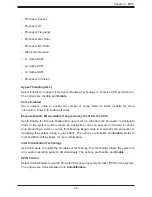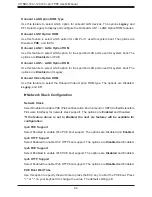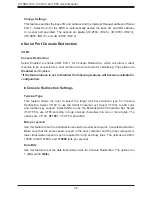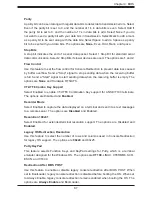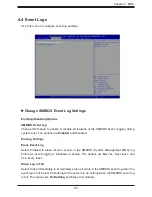
X11SDV-16C/-12C/-8C/-4C-TP8F User's Manual
82
PCIe/PCI/PnP Configuration
The following information will display:
•
PCI Bus Driver Version
•
PCI Devices Common Settings:
Above 4G Decoding (Available if the system supports 64-bit PCI decoding)
Select Enabled to decode a PCI device that supports 64-bit in the space above 4G Address.
The options are Disabled and
Enabled
.
SR-IOV Support
Use this feature to enable or disable Single Root IO Virtualization Support. The options are
Disabled
and Enabled.
BME DMA Mitigation
Enable this feature to help block DMA attacks. The options are Enable and
Disable
.
MMIO High Base
Use this feature to select the base memory size according to memory-address mapping for
the IO hub. The options are
56T
, 40T, 24T, 16T, 4T, and 1T.
MMIO High Granularity Size
Use this feature to select the high memory size according to memory-address mapping for
the IO hub. The options are 1G, 4G, 16G, 64G,
256G
, and 1024G.
Maximum Read Request
Use this feature to select the Maximum Read Request size of the PCI-Express device, or
select Auto to allow the System BIOS to determine the value. The options are
Auto
, 128
Bytes, 256 Bytes, 512 Bytes, 1024 Bytes, 2048 Bytes, and 4096 Bytes.
MMCFG Base
Use this feature to select the low base address for PCIE adapters to increase base memory.
The options are 1G, 1.5G, 1.75G,
2G
, 2.25G, and 3G.
NVMe Firmware Source
Use this feature to select the NVMe firmware to support booting. The options are
Vendor
Defined Firmware
and AMI Native Support. The default option, Vendor Firmware, is pre-
installed on the drive and may resolve errata or enable innovative functions for the drive. The
other option, AMI Native Support, is offered by the BIOS with a generic method.
Note: If you are using a PCIe NVMe SSD as a boot device, configure the following BIOS
steps below:


